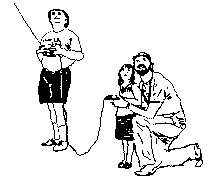This page will be updated from time to time. Come back soon


To make this a successful page, will require our club members to send the PREZ some of the shortcuts, sugestions,safety hints, or just better ways of building or flying model airplanes. The first six TIPS are primarily for the beginner pilot.
Tip:
If you are a new pilot don't try to fly without a experienced instructor. I know it looks easy, but flying on a buddy box will save you a lot of heart aches.and money. Try to schedule your training sessions close together, and you will succeed more rapidly.
Tip:
Join a R.C. Flying Club . Contact your local hobby Shop to locate a club in your locality
Tip:
Be sure that you read your club's safety rules and follow them.Here is a standard for all clubs,Don't fly over the pit.
Tip:
Don't buy someone elses junk..It is tough enough to learn to fly , with good equipment. There are many good trainers available. Buy a trainer kit, Such as a Eagle 2 by Goldberg.. Match the engine to the model.
TIP:
Build your first airplane. When you get it finished you will know every square inch of the model, how to setup the servos and all the controls. When at the field with your new airplane and something isn't quite right, you have a pretty good idea what's inside when you pull the wing.There is a great satisfaction taking a bunch of balsa sticks and making them fly.
If " time " is a problem, there are many great "Almost Ready to Fly" (ARF) models available.
There is one Ready To Fly (RTF) trainer which has been very impressive . Hobbico Nextstar trainer comes with a great engine,radio, and a simulator to practice flying on your home computer. It is priced around $400 dollars.Pretty much complete except for fuel and starting equipment. It is a very stable flyer well worth the money.
TIP:
Don't come to the field with a P_51 and expect your instructor to be a happy camper. Trainers only. After you try to fly it, you will find the trainer all the challenge you need..